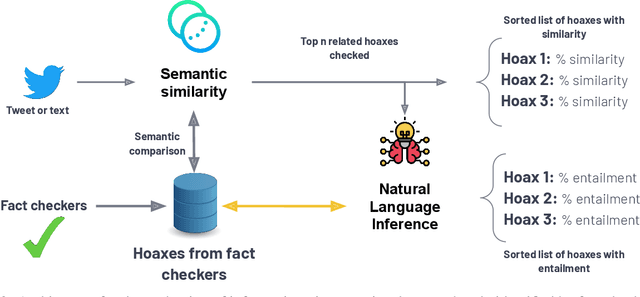Guillermo Villar-Rodríguez
DisTrack: a new Tool for Semi-automatic Misinformation Tracking in Online Social Networks
Aug 01, 2024Abstract:Introduction: This article introduces DisTrack, a methodology and a tool developed for tracking and analyzing misinformation within Online Social Networks (OSNs). DisTrack is designed to combat the spread of misinformation through a combination of Natural Language Processing (NLP) Social Network Analysis (SNA) and graph visualization. The primary goal is to detect misinformation, track its propagation, identify its sources, and assess the influence of various actors within the network. Methods: DisTrack's architecture incorporates a variety of methodologies including keyword search, semantic similarity assessments, and graph generation techniques. These methods collectively facilitate the monitoring of misinformation, the categorization of content based on alignment with known false claims, and the visualization of dissemination cascades through detailed graphs. The tool is tailored to capture and analyze the dynamic nature of misinformation spread in digital environments. Results: The effectiveness of DisTrack is demonstrated through three case studies focused on different themes: discredit/hate speech, anti-vaccine misinformation, and false narratives about the Russia-Ukraine conflict. These studies show DisTrack's capabilities in distinguishing posts that propagate falsehoods from those that counteract them, and tracing the evolution of misinformation from its inception. Conclusions: The research confirms that DisTrack is a valuable tool in the field of misinformation analysis. It effectively distinguishes between different types of misinformation and traces their development over time. By providing a comprehensive approach to understanding and combating misinformation in digital spaces, DisTrack proves to be an essential asset for researchers and practitioners working to mitigate the impact of false information in online social environments.
FacTeR-Check: Semi-automated fact-checking through Semantic Similarity and Natural Language Inference
Oct 27, 2021



Abstract:Our society produces and shares overwhelming amounts of information through the Online Social Networks (OSNs). Within this environment, misinformation and disinformation have proliferated, becoming a public safety concern on every country. Allowing the public and professionals to efficiently find reliable evidence about the factual veracity of a claim is crucial to mitigate this harmful spread. To this end, we propose FacTeR-Check, a multilingual architecture for semi-automated fact-checking that can be used for either the general public but also useful for fact-checking organisations. FacTeR-Check enables retrieving fact-checked information, unchecked claims verification and tracking dangerous information over social media. This architectures involves several modules developed to evaluate semantic similarity, to calculate natural language inference and to retrieve information from Online Social Networks. The union of all these modules builds a semi-automated fact-checking tool able of verifying new claims, to extract related evidence, and to track the evolution of a hoax on a OSN. While individual modules are validated on related benchmarks (mainly MSTS and SICK), the complete architecture is validated using a new dataset called NLI19-SP that is publicly released with COVID-19 related hoaxes and tweets from Spanish social media. Our results show state-of-the-art performance on the individual benchmarks, as well as producing useful analysis of the evolution over time of 61 different hoaxes.
 Add to Chrome
Add to Chrome Add to Firefox
Add to Firefox Add to Edge
Add to Edge